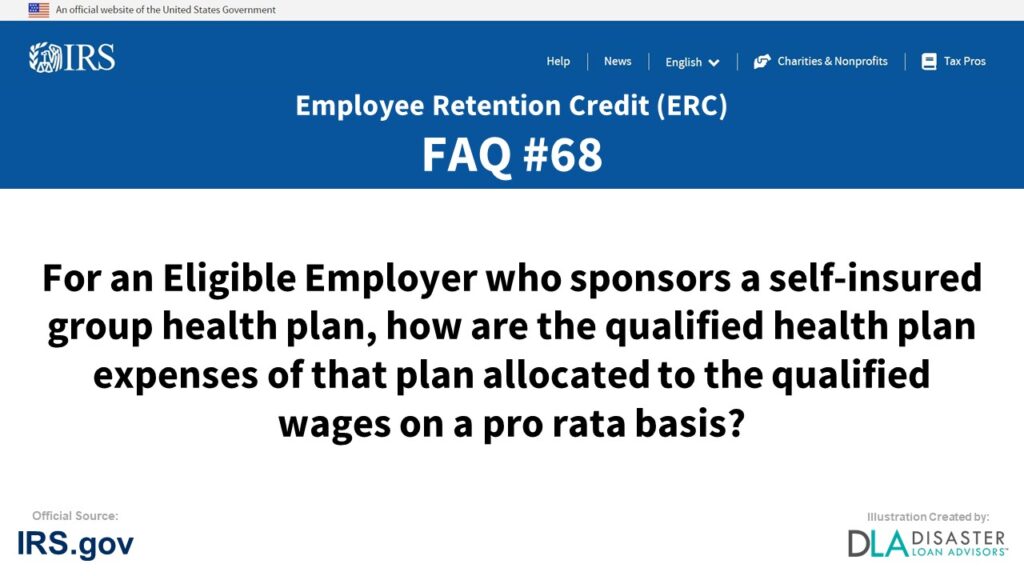
Frequently asked question #68 “For an Eligible Employer who sponsors a self-insured group health plan, how are the qualified health plan expenses of that plan allocated to the qualified wages on a pro rata basis?” under the Determining the Amount of Allocable Qualified Health Plan Expenses section of FAQs: Employee Retention Credit under the CARES Act, provided by the IRS.gov to help business owners understand the ERC program. Information is below for the question #68 For an Eligible Employer who sponsors a self-insured group health plan, how are the qualified health plan expenses of that plan allocated to the qualified wages on a pro rata basis?
ERC Credit Frequently Asked Question #68:
COVID-19-Related Employee Retention Credits:
Amount of Allocable Qualified Health Plan Expenses FAQs
68. For an Eligible Employer who sponsors a self-insured group health plan, how are the qualified health plan expenses of that plan allocated to the qualified wages on a pro rata basis?
An Eligible Employer who sponsors a self-insured group health plan may use any reasonable method to determine and allocate the health plan expenses, including (1) the COBRA applicable premium for the employee typically available from the administrator, or (2) any reasonable actuarial method to determine the estimated annual expenses of the plan.
If the Eligible Employer uses a reasonable actuarial method to determine the estimated annual expenses of the plan, then rules similar to the rules for insured plans are used to determine the amount of health plan expenses allocated to an employee.
That is, the estimated annual expense is divided by the number of employees covered by the plan, and that amount is divided by the average number of work days during the year by the employees (treating days of paid leave as work days and any day on which an employee performs any work as work days). The resulting amount is the amount allocated to each day of qualified wages. Adjustments should be made for employee after-tax contributions.
For more Internal Revenue Service (IRS) Department of the Treasury Employee Retention Credit (ERC) Amount of Allocable Qualified Health Plan Expenses FAQs, visit the official IRS.gov tax website.
Conclusion and Summary on ERC Credit FAQ #68. For an Eligible Employer who sponsors a self-insured group health plan, how are the qualified health plan expenses of that plan allocated to the qualified wages on a pro rata basis?
The “For an Eligible Employer who sponsors a self-insured group health plan, how are the qualified health plan expenses of that plan allocated to the qualified wages on a pro rata basis?” is Frequently Asked Question #68 of many commonly asked questions small business owners are wondering about how to file the Employee Retention Tax Credit (ERTC). The IRS ERC Tax Credit program is a confusing and complex process to determine the correct ERC calculations your business qualifies for. Answers to “For an Eligible Employer who sponsors a self-insured group health plan, how are the qualified health plan expenses of that plan allocated to the qualified wages on a pro rata basis?” and filling out form 941-X may change slightly from frequently updated rules and regulations from the IRS. Leave a comment below if you have further questions on ERC Credit FAQ #68.
Help Completing / Filing / Claiming the Employee Retention Credit (ERC)
Receive Up to a $26,000 ERC Credit from the IRS Per Employee
Disaster Loan Advisors can assist your business with the complex and confusing Employee Retention Credit (ERC), Form 941-X, and the Employee Retention Tax Credit (ERTC) program.
Depending on eligibility, business owners and companies can receive up to $26,000 per employee based on the number of W2 employees you had on the payroll in 2020 and 2021.
The ERC / ERTC Tax Credit Program is a valuable IRS tax credit you can claim. This is money you have already paid to the IRS in payroll taxes for your W2 employees.
We DO NOT charge a percentage (%) of your ERC Refund like some companies are charging. Some ERC firms out there are charging upwards of 15% to 35% of your ERC refund!
Our professional ERC fee and pricing structure is very reasonable in comparison.
If you are looking for an ERC Company that believes in providing professional ERC Services and value, in exchange for a fair, reasonable, and ethical fee for the amount of work required, Disaster Loan Advisors is a good fit for you.
Schedule Your Free Employee Retention Credit Consultation to see what amount of employee retention tax credit your company qualifies for.
Cover Image Credit: Irs.gov / ERC FAQ / Disaster Loan Advisors
